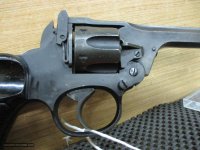Bob Wright
New member
The original thread by this name sparked my memory of many, many years ago, before GCA 1968 etc. During this era many surplus revolvers flooded the market. Many of these were of odd calibers, and distributors altered them to more common cartridges to make them more marketable, and sold for very attractive prices.
A bunch of S&W Terrier revolvers, and Colt Bankers Specials, original .38n S&W caliber, were simply reamed to take .38 Special cartridges. When fired, the .38 Special case bulged somewhat near the base, but so far as I know, no catastrophic failures occurred.
British Royal Irish Constabulary revolvers, .442 Calibers, had their chambers and barrels lined to convert to to .25-20 Winchester. It's hard to think of a more useless revolver conversion.
And Webley .455s had their cylinders shaved to accept .45 ACP w/half moon clips.
Surplus Colt New Service models from Canada, originally .455s, had their cylinders reamed to accept .45 Colt.
Many Colt New Service and Shingle Action Army models were converted to various .40 caliber. Among thse were the .401 Eimer or .401 Special. There were popular in my area among cotton men who had a private hunting club in the Mississippi Delta area that abounded with wild hogs.
And double action Colts (I never saw a converted S&W) M1917s were reamed to accept the .43 Eimer round. This round was a .44 (.429" bore or so) based on a shortened .30-06 case. The ACP cylinder bored out for the longer case, which was used with ACP half moon clips. (I never saw full moon clips until fairly recent times.)
In more modern times, Ruger Single Sixes were converted to various .22 and .25 centerfire cartridges. The late Frank Haas was a proponent of the .25 K-Chuck, based on the .22 Hornet.
These were made as the revolvers were sold at very attractive prices. My first Colt New Service was priced at $24.95, plus $5.00 more for select condition. Webleys and Enfield revolver were $14.95, and one holster maker offered a bucadero rig for $14.95 and would throw in a .45 revolver (A Webley too break) at no extra charge! Some of the Webley RICs went for the "Under $10,00 Page!"
Those were the days!
Bob Wright
A bunch of S&W Terrier revolvers, and Colt Bankers Specials, original .38n S&W caliber, were simply reamed to take .38 Special cartridges. When fired, the .38 Special case bulged somewhat near the base, but so far as I know, no catastrophic failures occurred.
British Royal Irish Constabulary revolvers, .442 Calibers, had their chambers and barrels lined to convert to to .25-20 Winchester. It's hard to think of a more useless revolver conversion.
And Webley .455s had their cylinders shaved to accept .45 ACP w/half moon clips.
Surplus Colt New Service models from Canada, originally .455s, had their cylinders reamed to accept .45 Colt.
Many Colt New Service and Shingle Action Army models were converted to various .40 caliber. Among thse were the .401 Eimer or .401 Special. There were popular in my area among cotton men who had a private hunting club in the Mississippi Delta area that abounded with wild hogs.
And double action Colts (I never saw a converted S&W) M1917s were reamed to accept the .43 Eimer round. This round was a .44 (.429" bore or so) based on a shortened .30-06 case. The ACP cylinder bored out for the longer case, which was used with ACP half moon clips. (I never saw full moon clips until fairly recent times.)
In more modern times, Ruger Single Sixes were converted to various .22 and .25 centerfire cartridges. The late Frank Haas was a proponent of the .25 K-Chuck, based on the .22 Hornet.
These were made as the revolvers were sold at very attractive prices. My first Colt New Service was priced at $24.95, plus $5.00 more for select condition. Webleys and Enfield revolver were $14.95, and one holster maker offered a bucadero rig for $14.95 and would throw in a .45 revolver (A Webley too break) at no extra charge! Some of the Webley RICs went for the "Under $10,00 Page!"
Those were the days!
Bob Wright

